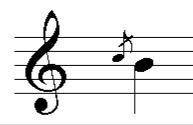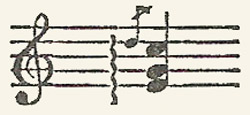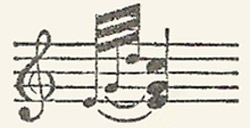acciaccatura

Double and triple appoggiatura.
The acciaccatura is a grace note which takes its time from the rest or note preceding the principal note to which it is attached. The acciaccatura is drawn as a small eighth note (quaver) with a line drawn through the flag and stem.
 |
The musical intention may be understood by knowing that the word comes from acciaccature – to crush. In performance the idea is to crush in the ornament as much as possible on the beat. There's bound to be a certain anticipation and this is fine if it is minute and the result is a crisp accenting of the principal note. Sometimes two or more small notes are shown before the principal notes, and then they generally amount to acciaccature (being in most cases performed on the 'crushed-in', or timeless and accentless, principle), although they have no strokes through their tails, and although the name double appoggiatura or triple appoggiatura is often given them.
Note a combination of acciaccatura with spread chord:
 |
performed as though notated:
 |
Although the acciaccatura is theoretically timeless, it nevertheless must take a tiny fragment of time from somewhere. In the cases shown above it takes it from the note which follows. In two other cases, however, it takes it from the note which precedes: (1) when, harmonically, and by considerations that common sense must determination, it clearly attaches to that note and not the following one; (2) when, in piano music, it appears in the bass followed by a chord in the left hand or in both hands – the composer's intention being to get the advantage of a richer harmony by sounding the bass note in a lower octave and then holding it by the pedal whilst the chord is played; in this case the chord (as a whole) is to be heard on the beat, the acciaccatura slightly preceding it.


